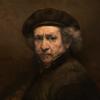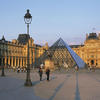More about Philosopher in Meditation
- All
- Info
- Shop

Sr. Contributor
When looking at Rembrandt van Rijn’s Philosopher in Meditation, it’s kind of difficult to see what is really going on.
The man (who may or may not be a philosopher) could be in deep thought or meditation. On the other hand, his eyes might just be tired from reading that thick book on the table. This painting, in the collection of the Louvre Museum, is a bit of a mystery; we don’t know for certain exactly who or what Rembrandt was trying to show in this image.
Rembrandt painted many biblical stories and scenes; some art historians have raised the possibility that this scene shows blind Tobit and his wife Anna. Rembrandt did paint Anna and the Blind Tobit, as well as Tobit and Anna with the Kid, which tells the story of a false accusation between a husband and his wife. Aside from the fact that each painting has an old bearded man and an old woman, there doesn’t seem to be much else that would tie them together. The Tobit character has eyes that are clearly meant to show his blindness, while the man in the Philosopher painting has his eyes cast down so we can’t see them. Anna was also usually pictured with her attribute, a spinning wheel, which is not present in Philosopher.
There is also at least one scholar who believes the painting is related to Plato's Allegory of the Cave, with the woman in the corner being a maid. This theory seems a bit of a stretch, but why not? Most theories on this painting are just that; another way of putting it is that all we really have are thought-out guesses. In 1842, the French poet Aloysius Bertrand claimed that the man in the painting was Rembrandt himself, and in 1956, the writer and, yes, philosopher, Aldous Huxley, said that the painting’s “symbolical subject matter,” was “nothing more nor less than the human mind” itself. He continued, “Its teeming darknesses, its moments of intellectual and visionary illumination, its mysterious stairways winding downward and upward into the unknown.”
These ideas probably make the painting even more of an enigma, certainly not less of one. One more strange piece of this puzzle lies with the extremely faint outline of a figure on the stairs; it’s faint to the point of almost being invisible, but is much clearer on 18th and 19th century engravings of the painting, such as this one by Devilliers l'aîné. It’s actually kind of creepy, as if there’s a ghost watching the “philosopher” while he meditates on his deep thoughts. In any case, it’s amazing that there are still things to argue about over an almost 400-year-old painting.
Sources
- Braider, Christopher. "The Art of Mis/Reading Art: Text, Image, and Modernity in Rembrandt’s Philosopher." In Refiguring the Real: Picture and Modernity in Word and Image, 1400-1700, 199-220. Princeton University Press, 1993. Accessed January 7, 2020. www
- Kitson, Michael. Rembrandt. New York: Phaidon, 1992.
- Ormiston, Rosalind. Rembrandt: His Life and Works in 500 Images. Wigston, Leicestershire: Lorenz Books, 2012.
- Westermann Mariët. Rembrandt. London: Phaidon, 2000.
- Yeazell, Ruth Bernard. "READING BY THE TITLE." In Picture Titles: How and Why Western Paintings Acquired Their Names, 81-96. Princeton; Oxford: Princeton University Press, 2015. Accessed January 7, 2020. www.jstor.org/stable/j.ctvc779dd.11.
Featured Content
Here is what Wikipedia says about Philosopher in Meditation
Philosopher in Meditation, recently renamed Philosopher in Contemplation by the museum, is the traditional title of an oil painting in the Musée du Louvre, Paris, that is attributed to the 17th-century Dutch artist Rembrandt.
It is signed "RHL-van Rijn" and dated 1632, at the time of Rembrandt's move from Leiden to Amsterdam. Recent scholarship suggests that the painting depicts "Tobit and Anna waiting for their son Tobias" instead. This interpretation is given in an auction catalogue from 1738 (see "Subject matter"), the earliest known source that clearly refers to this painting.
The painting was brought in the middle of the 18th century from The Hague to Paris, where it was associated with another painting ascribed to Rembrandt similar in size, style and motifs; i.e. a small figure in an interior with a spiral staircase (see "Companion piece"). Sold as pendants and identified as "Philosophers", the paintings enjoyed great popularity, making the rounds of major aristocratic collections before being acquired for the royal collections housed in the Louvre Palace. The presumed subject matter of philosophical meditation, the finely graded chiaroscuro treatment and the intricate composition were widely appreciated in France. The painting is mentioned in the writings of many 19th- and 20th-century literary figures, including George Sand, Théophile Gautier, Jules Michelet, Marcel Proust, Paul Valéry, Gaston Bachelard, Paul Claudel, and Aldous Huxley.
The ongoing popularity of the painting may be measured by its presence on the internet, where it is often used as an emblem of philosophy, or interpreted along esoteric or occult lines.
Check out the full Wikipedia article about Philosopher in Meditation













